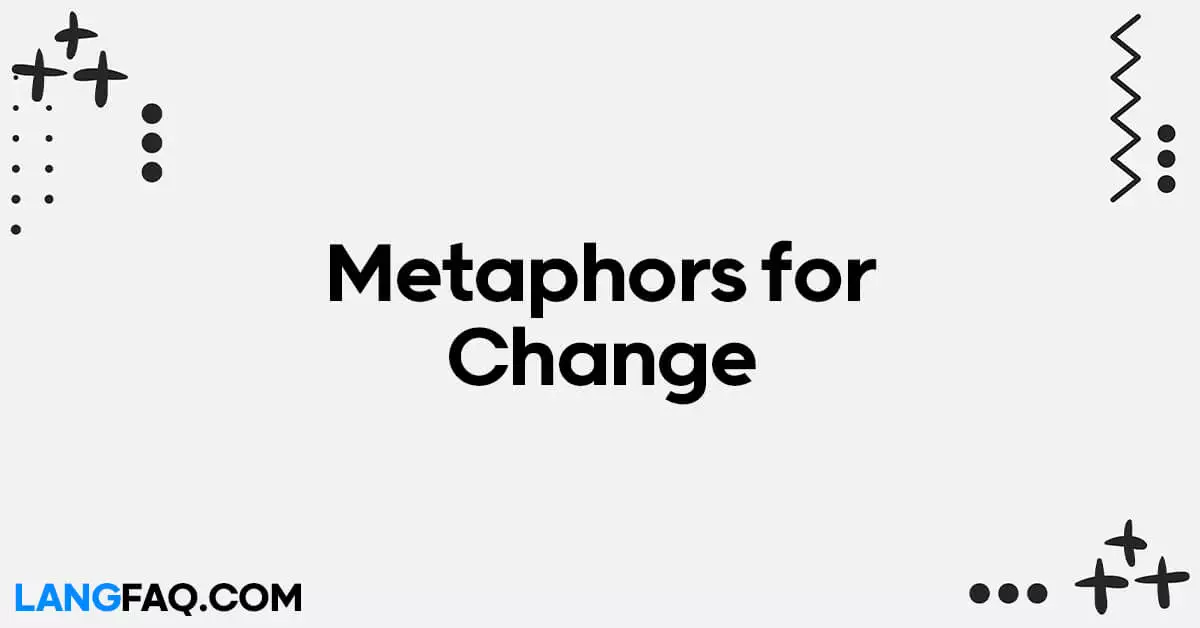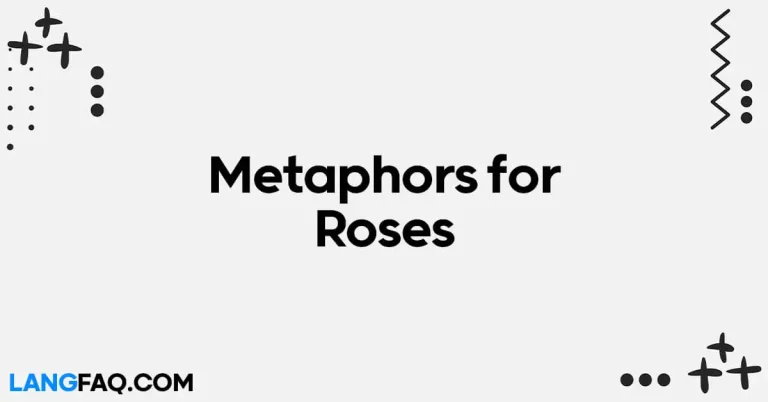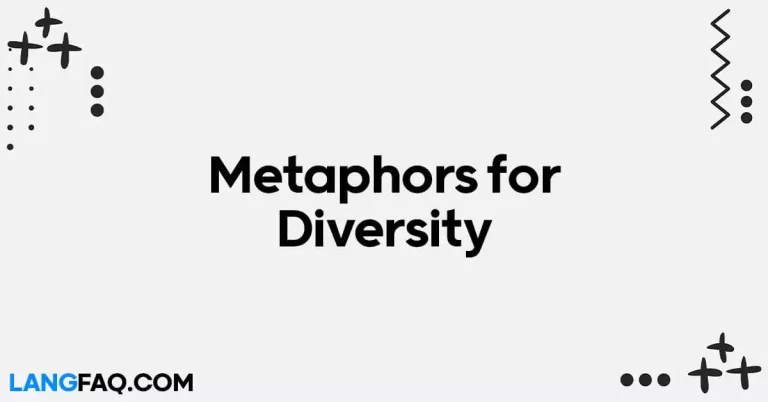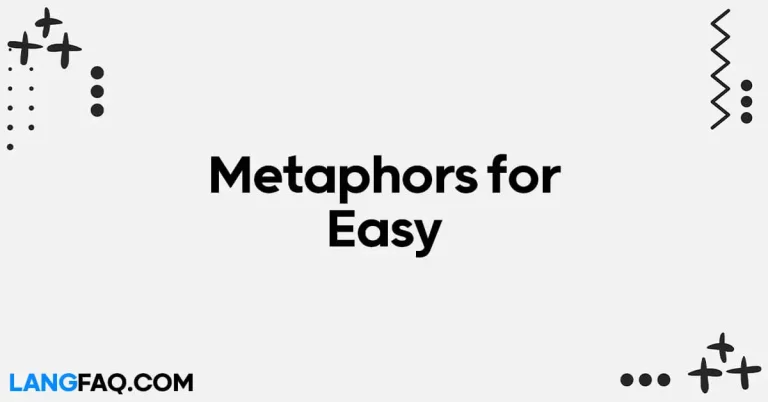Change is a fundamental part of life. It’s the force that propels us forward, challenges us, and ultimately leads to growth. But how do we understand and navigate this transformative process? One way is through metaphors – vivid and imaginative comparisons that help us grasp the essence of change.
In this article, we’ll explore 26 metaphors for change that shed light on its various facets. Each metaphor offers a unique perspective, making our journey through transformation an enriching experience.
26 Metaphors for Change: Exploring Varied Expressions
- The Turning of a New Leaf: Change is like turning a new leaf in the book of life, starting a fresh chapter.
- The Dawn of a New Day: Change is akin to the sunrise, bringing hope and new opportunities.
- The Unfolding of a Butterfly’s Wings: Change is the process of transformation, much like a butterfly emerging from its cocoon.
- The Shifting Sands of Time: Change is as constant and inevitable as the shifting sands of a desert.
- The Evolution of a Caterpillar into a Butterfly: Change is the journey of growth and development.
- The Rising Phoenix: Change is like the phoenix rising from its ashes, symbolizing rebirth and renewal.
- The Wind of Transformation: Change is like a powerful wind that can reshape landscapes and lives.
- The Breaking of Dawn: Change is the breaking of a new day, bringing light to the darkness of the unknown.
- The Blooming of a Flower: Change is the blossoming of potential and beauty.
- The River’s Constant Flow: Change is like a river that never stops moving forward.
- The Turning of Seasons: Change is cyclical, much like the changing of seasons.
- The Puzzle Pieces Falling into Place: Change is like rearranging the pieces of a puzzle until they form a coherent picture.
- The Blank Canvas of an Artist: Change offers a blank canvas for us to paint the picture of our future.
- The Chameleon’s Adaptation: Change requires us to adapt, much like a chameleon changing its colors to blend in.
- The Dance of Life: Change is a dance with its own rhythm and steps.
- The Gardener’s Care: Change is like tending to a garden, nurturing growth and beauty.
- The Journey of a Thousand Miles: Change often begins with a single step, leading to a transformative journey.
- The Alchemist’s Transformation: Change is a form of alchemy, turning the ordinary into the extraordinary.
- The Opening of a Door: Change opens new doors of opportunity and exploration.
- The Unfurling of a Sail: Change is like unfurling a sail to catch the winds of progress.
- The Casting of a Die: Change involves taking risks and making decisions that can alter our course.
- The Melting of Ice: Change can melt away the barriers that hold us back, allowing us to flow freely.
- The Bloom of a Blossom: Change is the emergence of beauty and potential.
- The Rising Tide: Change is like a rising tide that lifts all boats, propelling us forward.
- The Birth of a Star: Change can lead to the birth of something brilliant and luminous.
- The Phoenix’s Resurrection: Change is the opportunity for a rebirth, rising stronger from challenges.
These metaphors help us grasp the multi-faceted nature of change, illustrating its beauty, challenges, and transformative power.
Here’s a table showcasing the 26 metaphors for change:
| Metaphor | Description |
|---|---|
| The Turning of a New Leaf | Starting a fresh chapter in life. |
| The Dawn of a New Day | Bringing hope and new opportunities. |
| The Unfolding of a Butterfly’s Wings | Process of transformation and emergence. |
| The Shifting Sands of Time | Constant and inevitable like the shifting sands of a desert. |
| The Evolution of a Caterpillar into a Butterfly | Journey of growth and development. |
| The Rising Phoenix | Symbolizing rebirth and renewal. |
| The Wind of Transformation | Reshapes landscapes and lives. |
| The Breaking of Dawn | Bringing light to the darkness of the unknown. |
| The Blooming of a Flower | Blossoming of potential and beauty. |
| The River’s Constant Flow | Never stops moving forward. |
| The Turning of Seasons | Cyclical, like the changing of seasons. |
| The Puzzle Pieces Falling into Place | Rearranging pieces to form a coherent picture. |
| The Blank Canvas of an Artist | Opportunity to paint the picture of our future. |
| The Chameleon’s Adaptation | Requires adaptability, like a chameleon changing colors. |
| The Dance of Life | Has its own rhythm and steps. |
| The Gardener’s Care | Nurturing growth and beauty. |
| The Journey of a Thousand Miles | Often begins with a single step, leading to a transformative journey. |
| The Alchemist’s Transformation | Turning the ordinary into the extraordinary. |
| The Opening of a Door | Opens new doors of opportunity and exploration. |
| The Unfurling of a Sail | Catches the winds of progress. |
| The Casting of a Die | Involves taking risks and making decisions that can alter our course. |
| The Melting of Ice | Melts away barriers, allowing us to flow freely. |
| The Bloom of a Blossom | Emergence of beauty and potential. |
| The Rising Tide | Lifts all boats, propelling us forward. |
| The Birth of a Star | Leads to the birth of something brilliant and luminous. |
| The Phoenix’s Resurrection | Opportunity for a rebirth, rising stronger from challenges. |
This table provides a concise overview of each metaphor for change.
Turning Over a New Leaf
Definition: To make a fresh start or begin anew.
Usage: This phrase is commonly used in both formal and informal settings. In formal contexts, it can be applied to career changes, personal growth, or even corporate strategies. Informally, it’s used to signify personal resolutions and lifestyle changes.
Example Sentence (Formal): After the company’s financial setback, the CEO decided to turn over a new leaf by implementing a comprehensive restructuring plan.
Example Sentence (Informal): With the new year approaching, many people make resolutions to turn over a new leaf by adopting healthier habits.
Variations:
- “Starting afresh”
- “Embarking on a new chapter”
- “Beginning a new journey”
Embracing a Fresh Dawn
Definition: To welcome new opportunities and optimism.
Usage: This metaphor is often employed in formal settings, such as motivational speeches, vision statements, or strategic planning. It signifies a positive and forward-looking approach.
Example Sentence (Formal): The company’s leadership is committed to embracing a fresh dawn in innovation and technology.
Variations:
- “Welcoming a new beginning”
- “Embracing a brighter future”
- “Pioneering a new era”
Transforming like a Butterfly
Definition: To undergo a profound metamorphosis or personal growth.
Usage: This metaphor is versatile, suitable for both formal and informal contexts. It’s often used to describe personal development, life changes, or transitions.
Example Sentence (Formal): The organization aims to transform like a butterfly, evolving into a more agile and adaptive entity.
Example Sentence (Informal): Going through a challenging period can lead to personal transformation, much like a caterpillar becoming a butterfly.
Variations:
- “Metamorphosing into something greater”
- “Blossoming like a butterfly”
- “Evolving gracefully”
Navigating the Seasons of Change
Definition: To adapt to the natural cycles of change.
Usage: This metaphor is frequently used in formal contexts related to strategic planning, organizational change, or project management. It emphasizes the need to adapt to changing circumstances.
Example Sentence (Formal): Businesses that excel are those capable of navigating the seasons of change, adjusting strategies as needed.
Variations:
- “Adapting to the ebb and flow of change”
- “Riding the waves of transformation”
- “Managing change like the changing seasons”
The Artist’s Blank Canvas
Definition: To have the freedom and opportunity to create something new.
Usage: This metaphor is applicable both formally and informally. In formal settings, it can relate to innovation in product development, artistic endeavors, or marketing campaigns. Informally, it signifies personal creativity and self-expression.
Example Sentence (Formal): The marketing team sees this project as the artist’s blank canvas, allowing them to craft a unique campaign.
Example Sentence (Informal): Retirement can be seen as the beginning of a new phase, an artist’s blank canvas waiting to be painted with adventures and hobbies.
Variations:
- “Starting with a clean slate”
- “Crafting a masterpiece of change”
- “Painting one’s own future”
Bridging to New Horizons
Definition: To move towards unexplored opportunities.
Usage: This metaphor is frequently used in formal contexts, particularly in business, strategic planning, and vision statements. It signifies a proactive approach to change.
Example Sentence (Formal): The company aims to bridge to new horizons by expanding into international markets.
Variations:
- “Venturing into uncharted territory”
- “Crossing into a realm of possibilities”
- “Pioneering new frontiers”
Rearranging the Puzzle Pieces
Definition: To reorganize or restructure elements for clarity and coherence.
Usage: This metaphor is versatile and applicable in various formal contexts, such as organizational restructuring, problem-solving, or project management.
Example Sentence (Formal): The management team is in the process of rearranging the puzzle pieces to optimize the company’s operations.
Variations:
- “Restructuring for a clearer vision”
- “Reassembling the pieces of the puzzle”
- “Putting the pieces in the right place”
The Wind of Transformation
Definition: To experience change as a powerful and uncontrollable force.
Usage: This metaphor is suitable for both formal and informal contexts. It’s often used to describe significant life changes or global transformations.
Example Sentence (Formal): The financial crisis swept through the industry like a relentless wind of transformation, reshaping the landscape.
Example Sentence (Informal): Personal growth can sometimes feel like the wind of transformation, blowing away old habits and beliefs.
Variations:
- “The whirlwind of change”
- “The gusts of transformation”
- “The breeze of renewal”
The Clock’s Unceasing Ticking
Definition: To emphasize the continuous nature of change.
Usage: This metaphor is adaptable to both formal and informal settings. In formal contexts, it’s used to stress the need for timely action and adaptation.
Example Sentence (Formal): In the digital age, the clock’s unceasing ticking reminds us of the importance of staying ahead in the market.
Example Sentence (Informal): Life’s changes are like the clock’s unceasing ticking, urging us to make the most of each moment.
Variations:
- “The relentless march of time”
- “The perpetual movement of the clock”
- “The constant passage of moments”
Incorporating these alternative words and phrases into your vocabulary can enrich your expressions about change, whether you’re addressing colleagues in a formal meeting or discussing personal growth with friends. The versatility of these metaphors allows you to convey the nuances of change effectively.
The Dance of Transformation
Definition: To move through life’s changes with grace and rhythm.
Usage: This metaphor is often used in informal contexts to describe the fluidity of change and one’s ability to adapt to it. It implies an approach to change that is not only effective but also elegant.
Example Sentence (Informal): Life’s journey can be seen as a dance of transformation, where we learn to move gracefully through its twists and turns.
Variations:
- “Dancing through life’s changes”
- “Moving with the rhythm of transformation”
- “Navigating the dance of change”
The Gardener’s Tender Care
Definition: To nurture and cultivate change with patience and attention.
Usage: This metaphor is versatile and can be applied in both formal and informal contexts. It emphasizes the need for careful nurturing and development during periods of change.
Example Sentence (Formal): The successful implementation of the new project required the team’s collective effort, much like a gardener’s tender care for a garden.
Example Sentence (Informal): Personal growth is like tending to a garden; it requires patience and nurturing to see the blossoms of change.
Variations:
- “Nurturing change like a gardener”
- “Cultivating transformation with care”
- “Tending to the seeds of change”
The Journey of a Thousand Miles
Definition: To acknowledge that change often begins with a single, courageous step.
Usage: This metaphor is adaptable to both formal and informal contexts. It encourages taking action, no matter how small, to initiate change.
Example Sentence (Formal): The company’s commitment to sustainability started with a single step, recognizing that the journey of a thousand miles begins with one.
Example Sentence (Informal): Embarking on a new career can be daunting, but remember that the journey of a thousand miles begins with a single job application.
Variations:
- “Taking the first step toward change”
- “Starting the journey with a single stride”
- “Initiating transformation with one action”
The Alchemist’s Transformation
Definition: To turn ordinary elements into something extraordinary through change.
Usage: This metaphor is often used in formal contexts to describe innovative processes, creative endeavors, or the potential of change to elevate something to a higher level.
Example Sentence (Formal): The company’s commitment to sustainability is akin to the alchemist’s transformation, turning waste into valuable resources.
Variations:
- “Creating magic through change”
- “Elevating through transformation”
- “Turning the mundane into the exceptional”
The Opening of a Door
Definition: To signify new opportunities and fresh beginnings brought about by change.
Usage: This metaphor can be used in both formal and informal contexts to indicate the potential unlocked by change.
Example Sentence (Formal): The merger between the two companies represents the opening of a door to global markets and expanded product offerings.
Example Sentence (Informal): Graduating from college is like the opening of a door to a world of possibilities and new adventures.
Variations:
- “Entering a new realm through change”
- “Unlocking opportunities with transformation”
- “The doorway to new experiences”
The Unfurling of a Sail
Definition: To catch the winds of progress and move forward with change.
Usage: This metaphor is often used in formal contexts, particularly in business and strategic discussions. It emphasizes the need to harness change for advancement.
Example Sentence (Formal): The company’s strategic plan involves the unfurling of a sail, utilizing market changes as tailwinds to drive growth.
Variations:
- “Sailing toward progress through change”
- “Catching the winds of transformation”
- “Using change as a sail for success”
The Casting of a Die
Definition: To make decisive choices that can lead to significant change.
Usage: This metaphor is adaptable to both formal and informal contexts, indicating the importance of making choices that influence one’s future.
Example Sentence (Formal): The decision to expand into international markets is like the casting of a die; it will shape the company’s future.
Example Sentence (Informal): Choosing to pursue higher education can be a casting of the die that impacts your career trajectory.
Variations:
- “Making choices that alter the course of change”
- “Deciding the path of transformation”
- “Taking decisive actions for change”
The Melting of Ice
Definition: To describe how change can dissolve barriers and create fluidity.
Usage: This metaphor is versatile and can be applied in both formal and informal contexts. It signifies the transformative power of change in breaking down resistance.
Example Sentence (Formal): The new leadership team aims to facilitate organizational change by addressing resistance and allowing for the melting of ice within the company culture.
Example Sentence (Informal): Effective communication can be the key to melting the ice in personal relationships and fostering understanding.
Variations:
- “Breaking barriers through change”
- “Creating fluidity with transformation”
- “Thawing the frozen aspects of life”
These alternative metaphors for change offer a rich tapestry of expressions that can enhance your communication in various contexts. Whether you’re navigating corporate strategy or discussing personal growth with friends, these metaphors provide powerful and vivid ways to convey the essence of change. By incorporating them into your language, you’ll be better equipped to articulate the complexities and opportunities that change brings.
The Bloom of a Blossom
Definition: To describe the emergence of beauty and potential brought about by change.
Usage: This metaphor is versatile and can be applied to both formal and informal contexts. It signifies the idea that change can reveal hidden qualities and talents.
Example Sentence (Formal): The company’s investment in employee training has led to the bloom of a blossom, as staff members discover their untapped potential.
Example Sentence (Informal): Pursuing a new hobby can be the bloom of a blossom, unveiling your creative side and passions.
Variations:
- “Unveiling hidden talents through change”
- “Discovering new facets of oneself”
- “The blossoming of potential”
The Rising Tide
Definition: To indicate that change can lift and propel all aspects of life forward.
Usage: This metaphor is often used in formal contexts to convey the idea that positive changes can have widespread benefits.
Example Sentence (Formal): The implementation of sustainable practices in the industry can be the rising tide that lifts all companies towards a greener future.
Variations:
- “Elevating all boats through change”
- “A rising tide of progress”
- “Lifting everyone with transformation”
The Birth of a Star
Definition: To signify that change can lead to the emergence of something remarkable and brilliant.
Usage: This metaphor is adaptable to both formal and informal contexts. It emphasizes the potential for greatness that change can bring.
Example Sentence (Formal): The collaboration between the two tech giants resulted in the birth of a star product that quickly gained global recognition.
Example Sentence (Informal): Joining a new team at work can be the birth of a star, as your skills and contributions shine brightly.
Variations:
- “Creating brilliance through change”
- “The emergence of excellence”
- “A star born from transformation”
The Phoenix’s Resurrection
Definition: To describe the opportunity for rebirth and renewal that change brings.
Usage: This metaphor is often used in formal contexts to signify a fresh start or revival.
Example Sentence (Formal): After facing financial challenges, the company underwent a Phoenix’s resurrection, emerging stronger and more resilient.
Variations:
- “Reborn through change”
- “The revival of strength”
- “Rising from the ashes of transformation”
Incorporating these metaphors into your communication allows you to convey the profound and transformative nature of change effectively. Whether you’re discussing strategic decisions in a boardroom or sharing personal growth experiences with friends, these metaphors enhance your ability to articulate the impact and potential of change.
Pros and Cons of Using Metaphors for Change
Pros:
- Clarity: Metaphors simplify complex ideas, making them easier to understand.
- Emotion: They can evoke emotions, making your message more relatable.
- Memorability: People remember stories and metaphors better than plain facts.
- Universal Appeal: Metaphors are universally understood and can bridge language and cultural gaps.
Cons:
- Misinterpretation: Metaphors can be misinterpreted if the audience doesn’t share the same cultural references.
- Overuse: Using too many metaphors in one piece of communication can confuse or overwhelm the audience.
- Ineffectiveness: Some metaphors may not resonate with all audiences or situations.
- Contextual Sensitivity: The appropriateness of a metaphor depends on the context, and using the wrong one can backfire.
When and Where to Use Metaphors for Change
The effective use of metaphors for change depends on the context, audience, and the specific message you want to convey. Here’s a breakdown of when and where to use these metaphors:
In Professional Settings
- Boardroom Meetings: Metaphors can be powerful tools for persuading stakeholders or conveying complex strategies. For example, you can use “The Dance of Transformation” to describe a company’s adaptability.
- Leadership Addresses: Leaders often employ metaphors to inspire their teams. “Embracing a Fresh Dawn” can be used to signify a new phase for the organization.
- Business Presentations: When presenting data or strategies, metaphors can make your message more engaging. “Rearranging the Puzzle Pieces” can be used to explain a restructuring plan.
- Marketing and Branding: Metaphors are effective in branding and marketing campaigns. “The Artist’s Blank Canvas” can symbolize a brand’s potential for creativity and innovation.
In Personal Development
- Self-Help Books: Authors often use metaphors to convey personal growth concepts. “Transforming like a Butterfly” can illustrate the idea of personal transformation.
- Mentorship and Coaching: Mentors can use metaphors to guide their mentees through challenges. “The Journey of a Thousand Miles” can inspire action.
- Motivational Speeches: Speakers can employ metaphors to motivate and inspire their audience. “The Bloom of a Blossom” can signify the emergence of one’s potential.
In Everyday Conversations
- Friendships and Relationships: Metaphors can enhance personal conversations. “The Melting of Ice” can describe the resolution of conflicts between friends.
- Family Discussions: When discussing changes in family dynamics, metaphors can make the conversation more relatable. “The Turning of a New Leaf” can symbolize personal growth.
- Personal Reflection: Metaphors can help individuals make sense of their experiences. “The Phoenix’s Resurrection” can represent a fresh start in life.
In Creative Writing
- Fiction and Poetry: Writers often use metaphors to create vivid imagery and symbolism. “The Casting of a Die” can foreshadow a character’s significant decision.
- Screenplays and Scripts: Metaphors add depth to dialogues and character interactions. “The Unfurling of a Sail” can be used to symbolize a character’s journey of change.
In Educational Settings
- Teaching and Learning: Educators can use metaphors to simplify complex topics. “Navigating the Seasons of Change” can help students understand historical transformations.
- Student Presentations: Students can use metaphors to make their presentations more engaging. “The Alchemist’s Transformation” can explain a scientific process.
Grammar and Usage Tips
- Consistency: Stick to a single metaphor within a given piece of communication to avoid confusion.
- Contextual Relevance: Ensure that the chosen metaphor aligns with the topic and context.
- Audience Awareness: Consider whether your audience will be familiar with the metaphor’s reference.
- Avoid Clichés: Overused metaphors may lose their impact, so aim for freshness and originality.
- Clarity: Make sure the metaphor enhances understanding rather than obscures your message.
Exceptions and Cultural Sensitivity
It’s essential to be aware of cultural nuances and potential misinterpretations when using metaphors, especially in diverse or international contexts. What might be a well-understood metaphor in one culture may carry a different meaning or be entirely unfamiliar in another. Additionally, some metaphors may be sensitive or offensive in specific cultural or social contexts. Always exercise caution and sensitivity when selecting metaphors, especially in a multicultural or diverse audience.
In conclusion, metaphors for change are versatile tools that can enhance communication in various settings. Their power lies in their ability to evoke emotions, simplify complex ideas, and make messages more memorable. However, the successful use of metaphors requires careful consideration of the context, audience, and the specific message you want to convey. When used effectively, metaphors can add depth and impact to your communication, making it more relatable and engaging for your audience.
Frequently Asked Questions
How can I embrace change in my life?
Embracing change starts with a mindset shift. Instead of resisting it, try to see change as an opportunity for growth and learning. Be open to new experiences and challenges.
Is change always a positive thing?
Change can be both positive and negative, depending on how we perceive it. Even in difficult times, there are valuable lessons to be learned from change.
What can I do to navigate change more effectively?
To navigate change effectively, stay adaptable, seek support from others, and maintain a positive attitude. Remember that change is a part of life, and you have the power to shape its impact on you.
Can I initiate change in my life?
Absolutely! You have the agency to initiate change in your life. Start by setting clear goals and taking small steps toward them. Change begins with your actions.
How can I help others cope with change?
Supporting others through change involves active listening, empathy, and offering assistance when needed. Be a source of encouragement and understanding during their journey.
Are there any books or resources on change that you recommend?
Certainly! Some recommended books on change include “Who Moved My Cheese?” by Spencer Johnson and “The Power of Habit” by Charles Duhigg. These books offer valuable insights into navigating change.
Conclusion
Change is the unceasing melody of life, and these metaphors provide a symphony of understanding. Embrace change as you would a dear friend, for it carries the gift of transformation and growth. In the dance of life, let change be your partner, guiding you towards new horizons and endless possibilities.







